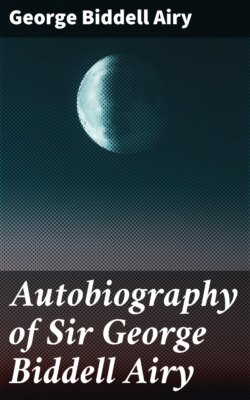Читать книгу Autobiography of Sir George Biddell Airy - George Biddell Airy - Страница 24
MATHEMATICAL SUBJECTS OF STUDY AND EXAMINATION.
ОглавлениеIn the October Term 1819, the only books on Pure Mathematics were:—Euclid generally, Algebra by Dr. Wood (formerly Tutor, but in 1819 Master, of St. John's College), Vince's Fluxions and Dealtry's Fluxions, Woodhouse's and other Trigonometries. Not a whisper passed through the University generally on the subject of Differential Calculus; although some papers (subsequently much valued) on that subject had been written by Mr. Woodhouse, fellow of Caius College; but their style was repulsive, and they never took hold of the University. Whewell's Mechanics (1819) contains a few and easy applications of the Differential Calculus. The books on applied Mathematics were Wood's Mechanics, Whewell's Mechanics, Wood's Optics, Vince's Hydrostatics, Vince's Astronomy, Woodhouse's Plane Astronomy (perhaps rather later), The First Book of Newton's Principia: I do not remember any others. These works were undoubtedly able; and for the great proportion of University students going into active life, I do not conceal my opinion that books constructed on the principles of those which I have cited were more useful than those exclusively founded on the more modern system. For those students who aimed at the mastery of results more difficult and (in the intellectual sense) more important, the older books were quite insufficient. More aspiring students read, and generally with much care, several parts of Newton's Principia, Book I., and also Book III. (perhaps the noblest example of geometrical form of cosmical theory that the world has seen). I remember some questions from Book III. proposed in the Senate-House Examination 1823.
In the October term 1819, I went up to the University. The works of Wood and Vince, which I have mentioned, still occupied the lecture-rooms. But a great change was in preparation for the University Course of Mathematics. During the great Continental war, the intercourse between men of science in England and in France had been most insignificant. But in the autumn of 1819, three members of the Senate (John Herschel, George Peacock, and Charles Babbage) had entered into the mathematical society of Paris, and brought away some of the works on Pure Mathematics (especially those of Lacroix) and on Mechanics (principally Poisson's). In 1820 they made a translation of Lacroix's Differential Calculus; and they prepared a volume of Examples of the Differential and Integral Calculus. These were extensively studied: but the form of the College Examinations or the University Examinations was not, I think, influenced by them in the winter 1820–1821 or the two following terms. But in the winter 1821–1822 Peacock was one of the Moderators; and in the Senate-House Examination, January 1822, he boldly proposed a Paper of important questions entirely in the Differential Calculus. This was considered as establishing the new system in the University. In January 1823, I think the two systems were mingled. Though I was myself subject to that examination, I grieve to say that I have forgotten much of the details, except that I well remember that some of the questions referred to Newton, Book III. on the Lunar Theory. To these I have already alluded.
No other work occurs to me as worthy of mention, except Woodhouse's Lunar Theory, entirely founded on the Differential Calculus. The style of this book was not attractive, and it was very little read.
